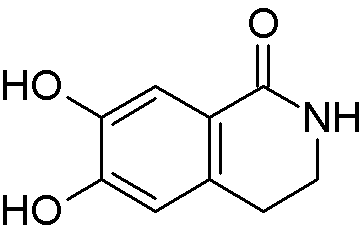6,7-Dihydroxy-3,4-dihydro-2H-isoquinolin-1-one is widely utilized in research focused on:
- Pharmaceutical Development: This compound is explored for its potential therapeutic effects, particularly in neuroprotective and anti-inflammatory applications, making it a candidate for drug formulation in treating neurodegenerative diseases.
- Antioxidant Research: Its antioxidant properties are being studied to develop supplements or functional foods that can help combat oxidative stress, which is linked to various chronic diseases.
- Biochemical Studies: Researchers use this compound to investigate its role in cellular signaling pathways, providing insights into its mechanism of action and potential health benefits.
- Natural Product Synthesis: It serves as a building block in organic synthesis, allowing chemists to create more complex molecules for use in various applications, including agrochemicals and pharmaceuticals.
- Cosmetic Formulations: The compound's skin-beneficial properties are being explored for incorporation into skincare products, targeting anti-aging and skin repair formulations.
General Information
Properties
Safety and Regulations
Applications
6,7-Dihydroxy-3,4-dihydro-2H-isoquinolin-1-one is widely utilized in research focused on:
- Pharmaceutical Development: This compound is explored for its potential therapeutic effects, particularly in neuroprotective and anti-inflammatory applications, making it a candidate for drug formulation in treating neurodegenerative diseases.
- Antioxidant Research: Its antioxidant properties are being studied to develop supplements or functional foods that can help combat oxidative stress, which is linked to various chronic diseases.
- Biochemical Studies: Researchers use this compound to investigate its role in cellular signaling pathways, providing insights into its mechanism of action and potential health benefits.
- Natural Product Synthesis: It serves as a building block in organic synthesis, allowing chemists to create more complex molecules for use in various applications, including agrochemicals and pharmaceuticals.
- Cosmetic Formulations: The compound's skin-beneficial properties are being explored for incorporation into skincare products, targeting anti-aging and skin repair formulations.
Documents
Safety Data Sheets (SDS)
The SDS provides comprehensive safety information on handling, storage, and disposal of the product.
Product Specification (PS)
The PS provides a comprehensive breakdown of the product’s properties, including chemical composition, physical state, purity, and storage requirements. It also details acceptable quality ranges and the product's intended applications.
Certificates of Analysis (COA)
Search for Certificates of Analysis (COA) by entering the products Lot Number. Lot and Batch Numbers can be found on a product’s label following the words ‘Lot’ or ‘Batch’.
*Catalog Number
*Lot Number
Certificates Of Origin (COO)
This COO confirms the country where the product was manufactured, and also details the materials and components used in it and whether it is derived from natural, synthetic, or other specific sources. This certificate may be required for customs, trade, and regulatory compliance.
*Catalog Number
*Lot Number
Safety Data Sheets (SDS)
The SDS provides comprehensive safety information on handling, storage, and disposal of the product.
DownloadProduct Specification (PS)
The PS provides a comprehensive breakdown of the product’s properties, including chemical composition, physical state, purity, and storage requirements. It also details acceptable quality ranges and the product's intended applications.
DownloadCertificates of Analysis (COA)
Search for Certificates of Analysis (COA) by entering the products Lot Number. Lot and Batch Numbers can be found on a product’s label following the words ‘Lot’ or ‘Batch’.
*Catalog Number
*Lot Number
Certificates Of Origin (COO)
This COO confirms the country where the product was manufactured, and also details the materials and components used in it and whether it is derived from natural, synthetic, or other specific sources. This certificate may be required for customs, trade, and regulatory compliance.


